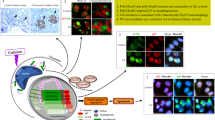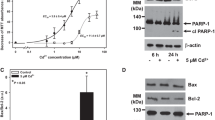Abstract
Cadmium damages renal cells, and in particular may cause mesangial cell death by necrosis or apoptosis, depending on exposure conditions in cultured cells. However, there is an uncertainty as to whether Cd2+-induced autophagy can protect mesangial cells against these other mechanisms of cell death. We have used autophagy-incompetent mouse embryonic fibroblast (MEF) cells lacking the Atg16 gene, as well as cultured rat mesangial cells (RMC) in which Atg16 has been silenced, to examine this issue. Measuring the processing of LC3-I to LC3-II and expression of sequestosome-1 (p62), we define conditions under which RMC can be induced to undergo autophagy in response to 0–20 µM CdCl2. Similarly, Cd2+ can initiate autophagy in MEF cells. However, when autophagy is compromised, either by gene knockout in MEF cells or by RNA silencing in RMC, cell viability is decreased, and concomitantly a Cd2+ dose-dependent increase in pro-caspase-3 cleavage indicates the initiation of apoptotic cell death. In contrast to some previous reports, Cd2+-induced autophagy is not correlated with increased levels of cellular reactive oxygen species but, among a panel of kinases investigated, is suppressed by inhibition of the Jun kinase. We conclude that concentrations of Cd2+ that initiate autophagy may afford renal mesangial cells some degree of protection against other modes (apoptosis, necrosis) of cell death.








Similar content being viewed by others
References
Åkesson A, Lundh T, Vahter M et al (2005) Tubular and glomerular kidney effects in Swedish women with low environmental cadmium exposure. Environ Health Perspect 113:1627–1631
Barth S, Glick D, Macleod KF (2010) Autophagy: assays and artifacts. J Pathol 221:117–124
Bjørkøy G, Lamark T, Brech A, Outzen H, Perander M, Overvatn A, Stenmark H, Johansen T (2005) p62/SQSTM1 forms protein aggregates degraded by autophagy and has a protective effect on huntingtin-induced cell death. J Cell Biol 171:603–614
Chargui A, Zekri S, Jacquillet G et al (2011) Cadmium-induced autophagy in rat kidney: an early biomarker of subtoxic exposure. Toxicol Sci 121:31–42
Chin TA, Templeton DM (1992) Effects of CdCl2 and Cd-metallothionein on cultured mesangial cells. Toxicol Appl Pharmacol 116:133–141
Choong G, Liu Y, Templeton DM (2013a) Cadmium affects focal adhesion kinase (FAK) in mesangial cells: involvement of CaMK-II and the actin cytoskeleton. J Cell Biochem 114:1832–1842
Choong G, Liu Y, Templeton DM (2013b) Cadmium-induced glutathionylation of actin occurs through a ROS-independent mechanism: implications for cytoskeletal integrity. Toxicol Appl Pharmacol 272:423–430
Ding W, Templeton DM (2000) Activation of parallel mitogen-activated protein kinase cascades and induction of c-fos by cadmium. Toxicol Appl Pharmacol 162:93–99
Dooley HC, Razi M, Polson HEJ, Girardin SE, Wilson MI, Tooze SA (2014) Autophagosome formation and pathogen clearance by recruiting Atg12–5-16L1. Mol Cell 55:238–252
Dorian C, Gattone VH II, Klaasen CD (1992) Renal cadmium deposition and injury as a result of accumulation of cadmium-metallothionein (CdMT) by the proximal convoluted tubules—a light microscopic autoradiography study with 109CdMT. Toxicol Appl Pharmacol 114:173–181
Drenckhahn D, Schnittler H, Nobiling R, Kriz W (1990) Ultrastructural organization of contractile proteins in rat glomerular mesangial cells. Am J Pathol 137:1343–1351
Friberg L (1984) Cadmium and the kidney. Environ Health Perspect 54:1–11
Fuchs Y, Steller H (2015) Live to die another way: modes of programmed cell death and the signals emanating from dying cells. Nat Rev Mol Cell Biol 16:329–344
Fujita N, Saitoh T, Kageyama S, Akira S, Noda T, Yoshimori T (2009) Differential involvement of Atg16L1 in Crohn disease and canonical autophagy: analysis of the Atg16L1 complex in fibroblasts. J Biol Chem 284:32602–32609
Gozuacik D, Bialik S, Raveh T et al (2008) DAP-kinase is a mediator of endoplasmic reticulum stress-induced caspase activation and autophagic cell death. Cell Death Differ 15:1875–1886
Gunawardana CG, Martinez RE, **ao W, Templeton DM (2006) Cadmium inhibits both intrinsic and extrinsic apoptotic pathways in renal mesangial cells. Am J Physiol 290:F1074–F1082
International Agency for Research on Cancer (1993) Beryllium, cadmium, mercury and exposures in the glass manufacturing industry, vol 58. IARC, Lyon
Järup L, Åkesson A (2009) Current status of cadmium as an environmental health problem. Toxicol Appl Pharmacol 238:201–208
Järup L, Persson B, Elinder CG (1995) Decreased glomerular filtration rate in solderers exposed to cadmium. Occup Environ Med 52:818–822
Johnson RJ (1994) The glomerular response to injury: progression or resolution? Kidney Int 45:1769–1782
Kato H, Katoh R, Kitamura M (2013) Dual regulation of cadmium-induced apoptosis by mTORC1 through selective induction of IRE1 branches in unfolded protein response. PLoS One 8:e64344
Kawada T, Koyama H, Suzuki S (1989) Cadmium, NAG activity, and β2-microglobulin in the urine of cadmium pigment workers. Br J Ind Med 46:52–55
Kimura T, Takabatake Y, Takahashi A et al (2011) Autophagy protects the proximal tubule from degeneration and acute ischemic injury. J Am Soc Nephrol 22:902–913
Kriz W, Elger M, Lemley K, Sakai T (1990) Structure of the glomerular mesangium: a biomechanical interpretation. Kidney Int 38:S2–S9
Kroemer G, Martin SJ (2005) Caspase-independent cell death. Nat Med 11:725–730
Lauwerys R, Bernard A, Roels H, Buchet J-P, Viau C (1984) Characterization of cadmium proteinuria in man and rat. Environ Health Perspect 54:147–152
Lauwerys R, Bernard A, Buchet J-P et al (1991) Does environmental exposure to cadmium represent a health risk? Conclusions from the Cadmibel study. Acta Clin Belg 46:219–225
Lee WK, Probst S, Santoyo-Sánchez MP et al (2017) Initial autophagic protection switches to disruption of autophagic flux by lysosomal instability during cadmium stress accrual in renal NRK-52E cells. Arch Toxicol. https://doi.org/10.1007/s00204-017-1942-9
Leist M, Jäättelä M (2001) Four deaths and a funeral: from caspases to alternative mechansms. Nat Rev Mol Cell Biol 2:1–10
Li M, Pi H, Yang Z et al (2016) Melatonin antagonizes cadmium-induced neurotoxicity by activating the transcription factor EB-dependent autophagy-lysosome machinery in mouse neuroblastoma cells. J Pineal Res 61:353–369
Liu Y, Templeton DM (2007) Cadmium activates CaMK-II and initiates CaMK-II-dependent apoptosis in mesangial cells. FEBS Lett 581:1481–1486
Liu Y, Templeton DM (2008) Initiation of caspase-independent death in mouse mesangial cells by Cd2+: involvement of p38 kinase and CaMK-II. J Cell Physiol 217:307–318
Liu Y, Song L, Templeton DM (2007) Heparin suppresses lipid raft-mediated signaling and ligand-independent EGF receptor activation. J Cell Physiol 211:205–212
Liu S, Hartleben B, Kretz O et al (2012) Autophagy plays a critical role in kidney tubule maintenance, aging and ischemia-reperfusion injury. Autophagy 8:826–837
Mizushima N (2007) Autophagy: process and function. Genes Dev 21:2861–2873
Mizushima N, Komatsu M (2011) Autophagy: renovation of cells and tissues. Cell 147:728–741
Nordberg GF (2009) Historical perspectives on cadmium toxicology. Toxicol Appl Pharmacol 238:192–200
Ogata M, S-i Hino, Saito A et al (2006) Autophagy is activated for cell survival after endoplasmic reticulum stress. Mol Cell Biol 26:9220–9231
Patel K, Harding P, Haney LB, Glass WF II (2003) Regulation of the mesangial cell myofibroblast phenotype by actin polymerization. J Cell Physiol 195:435–445
Prozialeck WC, Edwards JR (2010) Early biomarkers of cadmium exposure and nephrotoxicity. Biometals 23:793–809
Roels H, Bernard AM, Cardenas A et al (1993) Markers of early renal changes induced by industrial pollutants. Application to workers exposed to cadmium. Br J Ind Med 50:37–48
Schöcklmann HO, Lang S, Sterzel RB (1999) Regulation of mesangial cell proliferation. Kidney Int 56:1199–1207
Shimada H, Shiao YH, Shibata M-A, Waalkes MP (1998) Cadmium suppresses apoptosis induced by chromium. J Toxicol Environ Health 54:159–168
Shimizu S, Kanaseki T, Mizushima N et al (2004) Role of Bcl-2 family proteins in a non-apoptotic programmed cell death dependent on autophagy genes. Nat Cell Biol 6:1221–1228
Shimizu S, Konishi A, Nishida Y et al (2010) Involvement of JNK in the regulation of autophagic cell death. Oncogene 29:2070–2082
Suwazono Y, Sand S, Vahter M et al (2006) Benchmark dose for cadmium-induced renal effects in humans. Environ Health Perspect 114:1072–1076
Suwazono Y, Uetani M, Åkesson A, Vahter M (2010) Recent applications of benchmark dose method for estimation of reference cadmium exposure for renal effects in man. Toxicol Lett 198:40–43
Tait SW, Ichim G, Green DR (2014) Die another way–non-apoptotic mechanisms of cell death. J Cell Sci 127:2135–2144
Templeton DM, Chaitu N (1990) Effects of divalent metals on the isolated rat glomerulus. Toxicology 61:119–133
Templeton DM, Liu Y (2010) Multiple roles of cadmium in cell death and survival. Chem Biol Interact 188:267–275
Templeton DM, Liu Y (2013) Effects of cadmium on the actin cytoskeleton in renal mesangial cells. Can J Physiol Pharmacol 91:1–7
Thévenod F, Lee W-K (2013) Cadmium and cellular signaling cascades: interactions between cell death and survival pathways. Arch Toxicol 87:1743–1786
Thévenod F, Lee W-K (2015) Live and let die: roles of autophagy in cadmium nephrotoxicity. Toxics 3:130–151
Thomas LDK, Elinder C-G, Wolk A, Åkesson A (2014) Dietary cadmium exposure and chronic kidney disease: a population-based prospective cohort study of men and women. Int J Hyg Environ Health 217:720–725
Uriu K, Kaizu K, Komine N et al (1998) Renal hemodynamics in rats with cadmium-induced nephropathy. Toxicol Appl Pharmacol 150:76–85
Wang A, Templeton DM (1996) Inhibition of mitogenesis and c-fos expression in mesangial cells by heparin and heparan sulfates. Kidney Int 69:437–448
Wang Z, Templeton DM (1998) Induction of c-fos proto-oncogene in mesangial cells by cadmium. J Biol Chem 273:73–79
Wang SH, Shih YL, Ko WC, Wei YH, Shih CM (2008) Cadmium-induced autophagy and apoptosis are mediated by a calcium signaling pathway. Cell Mol Life Sci 65:3640–3652
Wang S-H, Shih Y-L, Kuo T-C, Ko W-C, Shih C-M (2009) Cadmium toxicity toward autophagy through ROS-activated GSK-3® in mesangial cells. Tox Sci 108:124–131
Wang Q-W, Wang Y, Wang T et al (2015a) Cadmium-induced autophagy is mediated by oxidative signaling in PC-12 cells and is associated with cytoprotection. Mol Med Rep 12:4448–4454
Wang T, Wang Q, Song R et al (2015b) Autophagy plays a cytoprotective role during cadmium-induced oxidative damage in primary neuronal cultures. Biol Trace Elem Res 168:481–489
Wang T, Wang Q, Song R et al (2016) Cadmium induced inhibition of autophagy is associated with microtubule disruption and mitochondrial dysfunction in primary rat cerebral cortical neurons. Neurotoxicol Teratol 53:11–18
**ao W, Liu Y, Templeton DM (2009) Pleiotropic effects of cadmium in mesangial cells. Toxicol Appl Pharmacol 238:315–326
Xu B, Chen S, Luo Y et al (2011) Calcium signaling is involved in cadmium-induced neuronal apoptosis via induction of reactive oxygen species and activation of MAPK/mTOR network. PLoS One 6:e19052
Yu L, Alva A, Su H et al (2004) Regulation of an ATG7-beclin 1 program of autophagic cell death by caspase-8. Science 304:1500–1502
Yuan J, Yankner BA (2000) Apoptosis in the nervous system. Nature 407:802–809
Acknowledgements
This work was funded by Grant #418208 to DMT from the Natural Sciences and Engineering Research Council of Canada.
Author information
Authors and Affiliations
Corresponding author
Ethics declarations
Conflict of interest
The authors declare that they have no conflict of interest.
Rights and permissions
About this article
Cite this article
Fujishiro, H., Liu, Y., Ahmadi, B. et al. Protective effect of cadmium-induced autophagy in rat renal mesangial cells. Arch Toxicol 92, 619–631 (2018). https://doi.org/10.1007/s00204-017-2103-x
Received:
Accepted:
Published:
Issue Date:
DOI: https://doi.org/10.1007/s00204-017-2103-x




